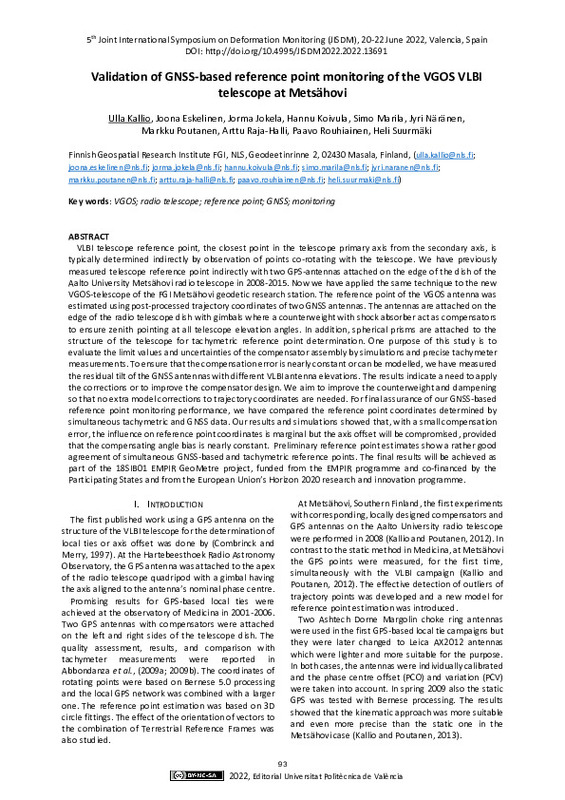JavaScript is disabled for your browser. Some features of this site may not work without it.
Buscar en RiuNet
Listar
Mi cuenta
Estadísticas
Ayuda RiuNet
Admin. UPV
Validation of GNSS-based reference point monitoring of the VGOS VLBI telescope at Metsähovi
Mostrar el registro sencillo del ítem
Ficheros en el ítem
| dc.contributor.author | Kallio, Ulla
|
es_ES |
| dc.contributor.author | Eskelinen, Joona
|
es_ES |
| dc.contributor.author | Jokela, Jorma
|
es_ES |
| dc.contributor.author | Koivula, Hannu
|
es_ES |
| dc.contributor.author | Marila, Simo
|
es_ES |
| dc.contributor.author | Näränen, Jyri
|
es_ES |
| dc.contributor.author | Poutanen, Markku
|
es_ES |
| dc.contributor.author | Raja-Halli, Arttu
|
es_ES |
| dc.contributor.author | Rouhiainen, Paavo
|
es_ES |
| dc.contributor.author | Suurmäki, Heli
|
es_ES |
| dc.coverage.spatial | east=24.3939796; north=60.2183765; name=Metsähovintie 114, 02540 Kirkkonummi, Finlàndia | es_ES |
| dc.date.accessioned | 2023-02-06T13:00:49Z | |
| dc.date.available | 2023-02-06T13:00:49Z | |
| dc.date.issued | 2023-01-27 | |
| dc.identifier.isbn | 9788490489796 | |
| dc.identifier.uri | http://hdl.handle.net/10251/191656 | |
| dc.description.abstract | [EN] VLBI telescope reference point, the closest point in the telescope primary axis from the secondary axis, is typically determined indirectly by observation of points co-rotating with the telescope. We have previously measured telescope reference point indirectly with two GPS-antennas attached on the edge of the dish of the Aalto University Metsähovi radio telescope in 2008-2015. Now we have applied the same technique to the new VGOS-telescope of the FGI Metsähovi geodetic research station. The reference point of the VGOS antenna was estimated using post-processed trajectory coordinates of two GNSS antennas. The antennas are attached on the edge of the radio telescope dish with gimbals where a counterweight with shock absorber act as compensators to ensure zenith pointing at all telescope elevation angles. In addition, spherical prisms are attached to the structure of the telescope for tachymetric reference point determination. One purpose of this study is to evaluate the limit values and uncertainties of the compensator assembly by simulations and precise tachymeter measurements. To ensure that the compensation error is nearly constant or can be modelled, we have measured the residual tilt of the GNSS antennas with different VLBI antenna elevations. The results indicate a need to apply the corrections or to improve the compensator design. We aim to improve the counterweight and dampening so that no extra model corrections to trajectory coordinates are needed. For final assurance of our GNSS-based reference point monitoring performance, we have compared the reference point coordinates determined by simultaneous tachymetric and GNSS data. Our results and simulations showed that, with a small compensation error, the influence on reference point coordinates is marginal but the axis offset will be compromised, provided that the compensating angle bias is nearly constant. Preliminary reference point estimates show a rather good agreement of simultaneous GNSS-based and tachymetric reference points. The final results will be achieved as part of the 18SIB01 EMPIR GeoMetre project, funded from the EMPIR programme and co-financed by the Participating States and from the European Union’s Horizon 2020 research and innovation programme. | es_ES |
| dc.format.extent | 6 | es_ES |
| dc.language | Inglés | es_ES |
| dc.publisher | Editorial Universitat Politècnica de València | es_ES |
| dc.relation.ispartof | 5th Joint International Symposium on Deformation Monitoring (JISDM 2022) | |
| dc.rights | Reconocimiento - No comercial - Compartir igual (by-nc-sa) | es_ES |
| dc.subject | VGOS antenna | es_ES |
| dc.subject | Sistema Global de Navegación por Satélite (GNSS) | es_ES |
| dc.subject | Radio telescope | es_ES |
| dc.subject | Reference point | es_ES |
| dc.subject | Monitoring techniques | es_ES |
| dc.title | Validation of GNSS-based reference point monitoring of the VGOS VLBI telescope at Metsähovi | es_ES |
| dc.type | Capítulo de libro | es_ES |
| dc.type | Comunicación en congreso | es_ES |
| dc.identifier.doi | 10.4995/JISDM2022.2022.13691 | |
| dc.relation.projectID | info:eu-repo/grantAgreement/EC/H2020/18SIB01/Large-scale dimensional measurements for geodesy/GeoMETRE | es_ES |
| dc.rights.accessRights | Abierto | es_ES |
| dc.description.bibliographicCitation | Kallio, U.; Eskelinen, J.; Jokela, J.; Koivula, H.; Marila, S.; Näränen, J.; Poutanen, M.... (2023). Validation of GNSS-based reference point monitoring of the VGOS VLBI telescope at Metsähovi. En 5th Joint International Symposium on Deformation Monitoring (JISDM 2022). Editorial Universitat Politècnica de València. 93-98. https://doi.org/10.4995/JISDM2022.2022.13691 | es_ES |
| dc.description.accrualMethod | OCS | es_ES |
| dc.relation.conferencename | 5th Joint International Symposium on Deformation Monitoring | es_ES |
| dc.relation.conferencedate | Junio 20-22, 2022 | es_ES |
| dc.relation.conferenceplace | València, España | es_ES |
| dc.relation.publisherversion | http://ocs.editorial.upv.es/index.php/JISDM/JISDM2022/paper/view/13691 | es_ES |
| dc.description.upvformatpinicio | 93 | es_ES |
| dc.description.upvformatpfin | 98 | es_ES |
| dc.type.version | info:eu-repo/semantics/publishedVersion | es_ES |
| dc.relation.pasarela | OCS\13691 | es_ES |
| dc.contributor.funder | European Commission | es_ES |
| dc.contributor.funder | Academy of Finland |








